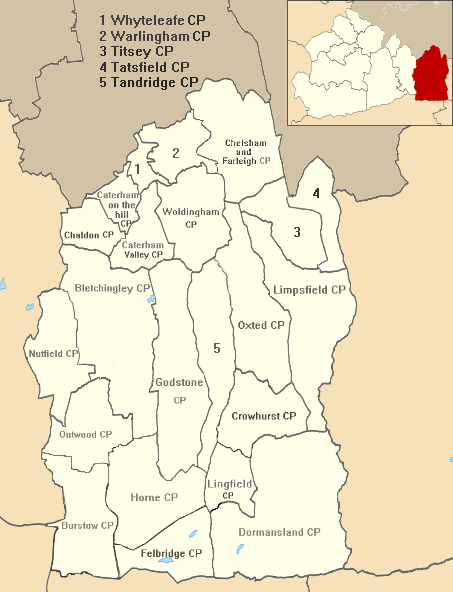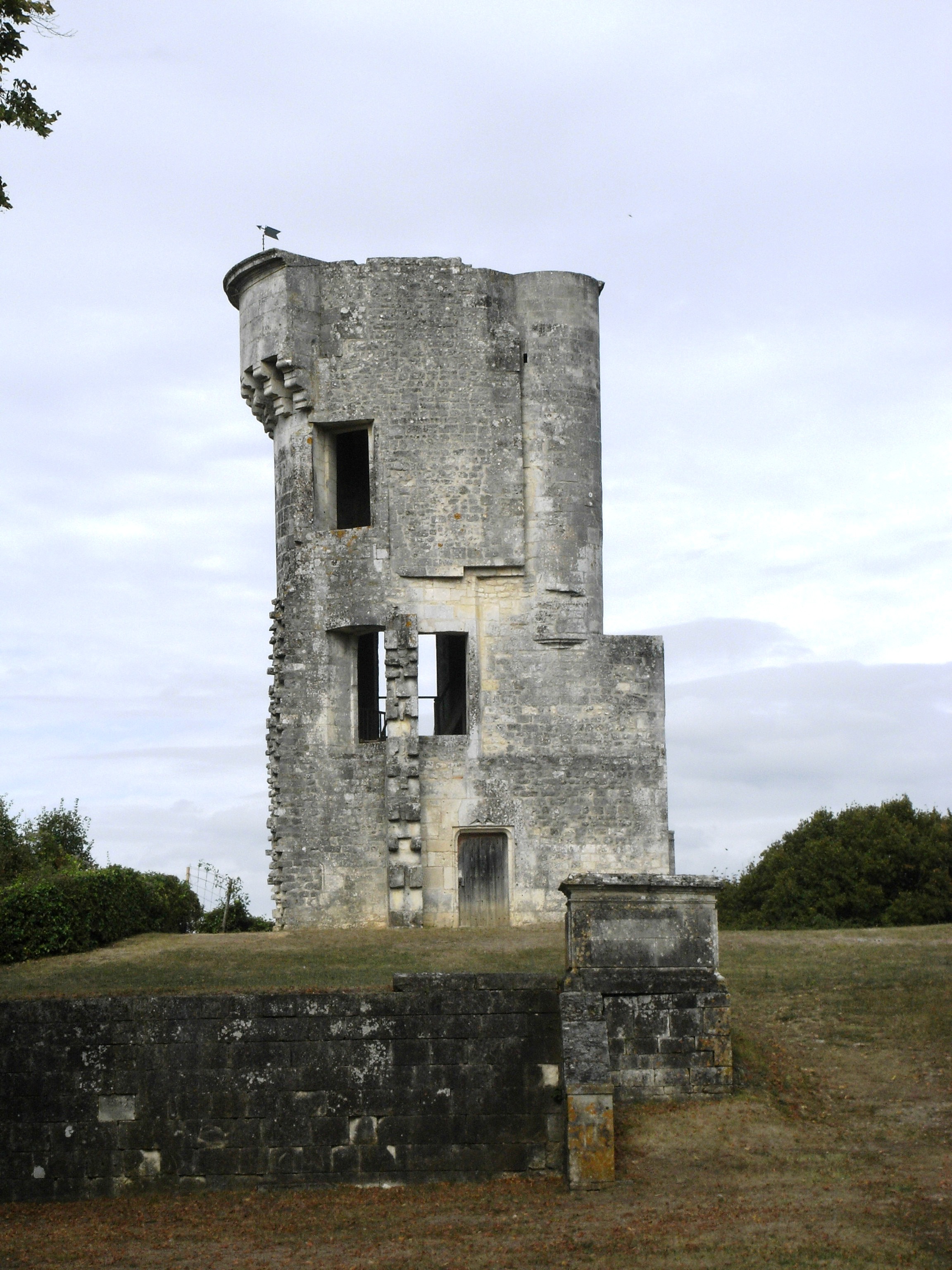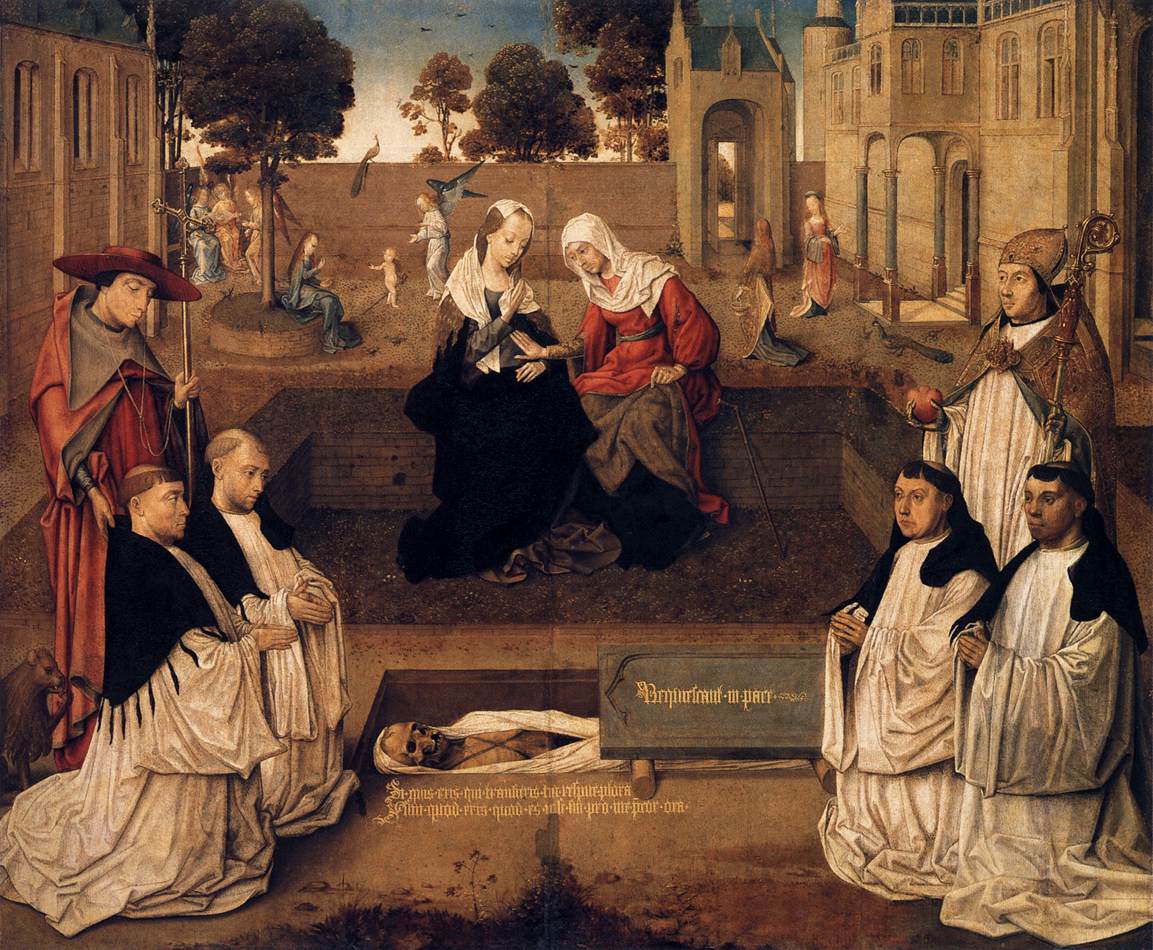|
Tandridge, Surrey
Tandridge is a village and civil parish in the Tandridge District, in the county of Surrey, England. Its nucleus is on a rise of the Greensand Ridge between Oxted and Godstone. It includes, towards its middle one named sub-locality (hamlet), Crowhurst Lane End. In 2011 the parish had a population of 663 and the district had a population of 82,998. In landmarks it has one of the oldest yew trees in the country, a Grade I-listed church and the tomb of the church's main benefactor Sir George Gilbert Scott's wife, Lady Scott who lived in the parish. The village is acknowledged locally for its friendly atmosphere and sense of community. There is active use of the village hall from the annual Christmas show to many parties and social events. The Village fete and Bonfire events are well attended and add to the sense of village community. History Middle Ages The village lay within the Anglo-Saxon Tandridge hundred. Tandridge appears in Domesday Book of 1086 as ''Tenrige''. It w ... [...More Info...] [...Related Items...] OR: [Wikipedia] [Google] [Baidu] |
United Kingdom Census 2011
A Census in the United Kingdom, census of the population of the United Kingdom is taken every ten years. The 2011 census was held in all countries of the UK on 27 March 2011. It was the first UK census which could be completed online via the Internet. The Office for National Statistics (ONS) is responsible for the census in England and Wales, the General Register Office for Scotland (GROS) is responsible for the census in Scotland, and the Northern Ireland Statistics and Research Agency (NISRA) is responsible for the census in Northern Ireland. The Office for National Statistics is the executive office of the UK Statistics Authority, a non-ministerial department formed in 2008 and which reports directly to Parliament. ONS is the UK Government's single largest statistical producer of independent statistics on the UK's economy and society, used to assist the planning and allocation of resources, policy-making and decision-making. ONS designs, manages and runs the census in England an ... [...More Info...] [...Related Items...] OR: [Wikipedia] [Google] [Baidu] |
Domesday Book
Domesday Book ( ; the Middle English spelling of "Doomsday Book") is a manuscript record of the Great Survey of much of England and parts of Wales completed in 1086 at the behest of William the Conqueror. The manuscript was originally known by the Latin name , meaning "Book of Winchester, Hampshire, Winchester", where it was originally kept in the royal treasury. The ''Anglo-Saxon Chronicle'' states that in 1085 the king sent his agents to survey every shire in England, to list his holdings and dues owed to him. Written in Medieval Latin, it was Scribal abbreviation, highly abbreviated and included some vernacular native terms without Latin equivalents. The survey's main purpose was to record the annual value of every piece of landed property to its lord, and the resources in land, labour force, and livestock from which the value derived. The name "Domesday Book" came into use in the 12th century. Richard FitzNeal wrote in the ( 1179) that the book was so called because its de ... [...More Info...] [...Related Items...] OR: [Wikipedia] [Google] [Baidu] |
Richard I Of England
Richard I (8 September 1157 – 6 April 1199), known as Richard the Lionheart or Richard Cœur de Lion () because of his reputation as a great military leader and warrior, was King of England from 1189 until his death in 1199. He also ruled as Duke of Normandy, Duke of Aquitaine, Aquitaine, and Duchy of Gascony, Gascony; Lord of Cyprus in the Middle Ages, Cyprus; Count of Poitiers, Counts and dukes of Anjou, Anjou, Count of Maine, Maine, and Count of Nantes, Nantes; and was overlord of Brittany at various times during the same period. He was the third of five sons of Henry II of England and Eleanor of Aquitaine and was therefore not expected to become king, but his two elder brothers predeceased their father. By the age of 16, Richard had taken command of his own army, putting down rebellions in Poitou against his father. Richard was an important Christian commander during the Third Crusade, leading the campaign after the departure of Philip II of France and achieving sev ... [...More Info...] [...Related Items...] OR: [Wikipedia] [Google] [Baidu] |
Austin Canons
The Canons Regular of St. Augustine are Catholic priests who live in community under a rule ( and κανών, ''kanon'', in Greek) and are generally organised into religious orders, differing from both secular canons and other forms of religious life, such as clerics regular, designated by a partly similar terminology. As religious communities, they have laybrothers as part of the community. At times, their Orders have been very popular: in England in the 12th century, there were more houses of canons (often referred to as an abbey or canonry) than monasteries of monks. Preliminary distinctions All canons regular are to be distinguished from secular canons who belong to a resident group of priests but who do not take public vows and are not governed in whatever elements of life they lead in common by a historical rule. One obvious place where such groups of priests are required is at a cathedral, where there were many Masses to celebrate and the Divine Office to be prayed t ... [...More Info...] [...Related Items...] OR: [Wikipedia] [Google] [Baidu] |
Caterham
Caterham () is a town in the Tandridge (district), Tandridge district of Surrey, England. The town is administratively divided into two: Caterham on the Hill, and Caterham Valley, which includes the main town centre in the middle of a dry valley but rises to equal heights to the south. The town lies close to the A22 road, A22, from Guildford and south of Croydon, in an upper valley cleft into the dip slope of the North Downs. Caterham on the Hill is above the valley to the west. History An encampment on the top of White Hill, in Caterham Valley south of Caterham School, between Bletchingley and the town centre is called ''The Cardinal's Cap'' which was excavated and inspected in designating it a Scheduled monument, Scheduled Ancient Monument. With close ramparts forming two or more lines, archaeology, archaeologists describe the fort as a "large Hill fort#Types, multivallate hillfort at War Coppice Camp". The town lies within the Anglo-Saxons, Anglo-Saxon feudal system, ... [...More Info...] [...Related Items...] OR: [Wikipedia] [Google] [Baidu] |
Middle Ages
In the history of Europe, the Middle Ages or medieval period lasted approximately from the 5th to the late 15th centuries, similarly to the post-classical period of global history. It began with the fall of the Western Roman Empire and transitioned into the Renaissance and the Age of Discovery. The Middle Ages is the middle period of the three traditional divisions of Western history: classical antiquity, the medieval period, and the modern period. The medieval period is itself subdivided into the Early, High, and Late Middle Ages. Population decline, counterurbanisation, the collapse of centralised authority, invasions, and mass migrations of tribes, which had begun in late antiquity, continued into the Early Middle Ages. The large-scale movements of the Migration Period, including various Germanic peoples, formed new kingdoms in what remained of the Western Roman Empire. In the 7th century, North Africa and the Middle East—once part of the Byzantine Empire� ... [...More Info...] [...Related Items...] OR: [Wikipedia] [Google] [Baidu] |
Feet Of Fines
A foot of fine (plural, feet of fines; Latin: ''pes finis''; plural, ''pedes finium'') is the archival copy of the agreement between two parties in an English lawsuit over land, most commonly the fictitious suit (in reality a conveyance) known as a fine of lands or final concord. The procedure was followed from around 1195 until 1833, and the considerable body of resulting records is now held at The National Archives, Kew, London. History In the reign of Henry II of England, the royal justices first began the practice of registering the settlement of disagreements over land by having both parties bring a suit before the royal courts. The resulting decision was thus given ''royal sanction''. At first, two copies of the agreement ("fine") were made, created as chirographs: i.e. the text was written in duplicate on a single piece of parchment, which was then cut in half, one copy going to each of the litigants. Under Hubert Walter's justiciarship, probably about 1195, the practice ... [...More Info...] [...Related Items...] OR: [Wikipedia] [Google] [Baidu] |
Feudal System
Feudalism, also known as the feudal system, was a combination of legal, economic, military, cultural, and political customs that flourished in medieval Europe from the 9th to 15th centuries. Broadly defined, it was a way of structuring society around relationships derived from the holding of land in exchange for service or labour. The classic definition, by François Louis Ganshof (1944), François Louis Ganshof (1944). ''Qu'est-ce que la féodalité''. Translated into English by Philip Grierson as ''Feudalism'', with a foreword by F. M. Stenton, 1st ed.: New York and London, 1952; 2nd ed: 1961; 3rd ed.: 1976. describes a set of reciprocal legal and military obligations of the warrior nobility and revolved around the key concepts of lords, vassals, and fiefs. A broader definition, as described by Marc Bloch (1939), includes not only the obligations of the warrior nobility but the obligations of all three estates of the realm: the nobility, the clergy, and the peasan ... [...More Info...] [...Related Items...] OR: [Wikipedia] [Google] [Baidu] |
Hog (swine)
The pig (''Sus domesticus''), also called swine (: swine) or hog, is an omnivorous, domesticated, even-toed, hoofed mammal. It is named the domestic pig when distinguishing it from other members of the genus '' Sus''. Some authorities consider it a subspecies of ''Sus scrofa'' (the wild boar or Eurasian boar); other authorities consider it a distinct species. Pigs were domesticated in the Neolithic, both in China and in the Near East (around the Tigris Basin). When domesticated pigs arrived in Europe, they extensively interbred with wild boar but retained their domesticated features. Pigs are farmed primarily for meat, called pork. The animal's skin or hide is used for leather. China is the world's largest pork producer, followed by the European Union and then the United States. Around 1.5 billion pigs are raised each year, producing some 120 million tonnes of meat, often cured as bacon. Some are kept as pets. Pigs have featured in human culture since Neolithic times, a ... [...More Info...] [...Related Items...] OR: [Wikipedia] [Google] [Baidu] |
Woodland
A woodland () is, in the broad sense, land covered with woody plants (trees and shrubs), or in a narrow sense, synonymous with wood (or in the U.S., the '' plurale tantum'' woods), a low-density forest forming open habitats with plenty of sunlight and limited shade (see differences between British, American and Australian English explained below). Some savannas may also be woodlands, such as ''savanna woodland'', where trees and shrubs form a light canopy. Woodlands may support an understory of shrubs and herbaceous plants including grasses. Woodland may form a transition to shrubland under drier conditions or during early stages of primary or secondary succession. Higher-density areas of trees with a largely closed canopy that provides extensive and nearly continuous shade are often referred to as forests. Extensive efforts by conservationist groups have been made to preserve woodlands from urbanization and agriculture. For example, the woodlands of Northwest Indiana ha ... [...More Info...] [...Related Items...] OR: [Wikipedia] [Google] [Baidu] |
Meadow
A meadow ( ) is an open habitat or field, vegetated by grasses, herbs, and other non- woody plants. Trees or shrubs may sparsely populate meadows, as long as they maintain an open character. Meadows can occur naturally under favourable conditions but are often artificially created from cleared shrub or woodland for the production of hay, fodder or livestock. Meadow habitats as a group are characterized as semi-natural grasslands, meaning that they are largely composed of species native to the region, with only limited human intervention. Meadows attract a multitude of wildlife and support flora and fauna that could not thrive in other habitats. They are ecologically important since they provide areas for animal courtship displays, nesting, food gathering, pollinating insects, and sometimes sheltering if the vegetation is high enough. Intensified agricultural practices (too frequent mowing, use of mineral fertilizers, manure and insecticides) may lead to declin ... [...More Info...] [...Related Items...] OR: [Wikipedia] [Google] [Baidu] |
Plough
A plough or ( US) plow (both pronounced ) is a farm tool for loosening or turning the soil before sowing seed or planting. Ploughs were traditionally drawn by oxen and horses but modern ploughs are drawn by tractors. A plough may have a wooden, iron or steel frame with a blade attached to cut and loosen the soil. It has been fundamental to farming for most of history. The earliest ploughs had no wheels; such a plough was known to the Romans as an ''aratrum''. Celtic peoples first came to use wheeled ploughs in the Roman era. The prime purpose of ploughing is to turn over the uppermost soil, bringing fresh nutrients to the surface while burying weeds and crop remains to decay. Trenches cut by the plough are called furrows. In modern use, a ploughed field is normally left to dry and then harrowed before planting. Ploughing and cultivating soil evens the content of the upper layer of soil, where most plant feeder roots grow. Ploughs were initially powered by humans, but th ... [...More Info...] [...Related Items...] OR: [Wikipedia] [Google] [Baidu] |









